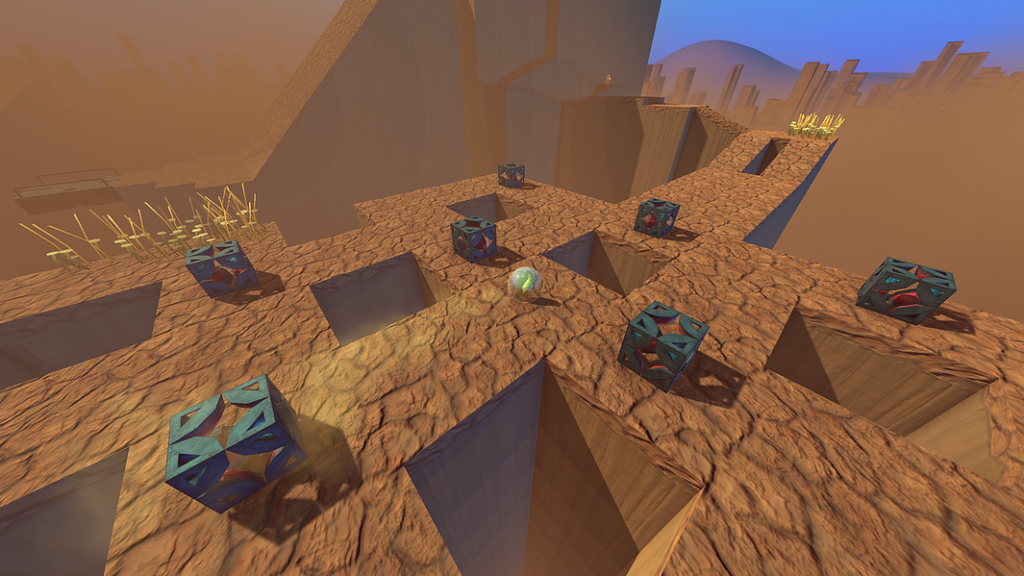If you love classic arcade games, you might recall Marble Madness, where you had to navigate a ball through a world of brain-teasing obstacles. More recent takes on the gameplay style include the Super Monkey Ball series, where players tilt the entire level around to get the ball (and the energetic monkey inside) to its goal. It’s a game style that never really goes out of fashion, and the developers at Lightning Rock (based out of Canberra, Australia) are looking to bring that sense of old-school nostalgia to virtual reality with the game Marble Mountain, which releases April 5 on Steam.
Designed for both normal monitors and high-end VR headsets like the Oculus Rift and HTC Vive, Marble Mountain challenges players to guide a marble across gigantic, animated, 3D environments as if it were an Indiana Jones-style adventure.
Shannon Pickles, CEO of Lightning Rock, talked to [a]listdaily about bringing a little old-school gameplay to new technology, and how to avoid losing your marbles.
 What inspired you to make a puzzle game for VR?
What inspired you to make a puzzle game for VR?
The company is basically a group of mates in our mid-thirties that grew up with a love and passion for playing computer games. One of the best experiences we all remembered from our childhood was playing Marble Madness, either on our Amigas or down in the local takeaway store on an arcade machine.
So, when we decided to move into making games ourselves it seemed a natural fit to try and see if we could take that classic retro arcade fun and blend it with modern graphics and technology.
The other real factor though is we really felt that more could be done with VR. Back when we started development the vast majority of VR demos coming out were limited to First Person Shooters or Simulators, and we felt there was definitely a market for third-person-view puzzle titles like Marble Mountain.
What convinced you to develop for Oculus VR and Vive, as opposed to mobile VR (Gear VR and Google Cardboard)?
To be honest we did try to make the game work at one stage on mobile devices, and it just didn’t work well. While still fun, the accelerometer controls couldn’t quite offer the gameplay feel we were after, and the limitations on the processing power of mobile devices meant we really couldn’t go with the art style and graphics we were looking for.
How does VR enhance the experience, compared to a normal monitor?
To me, the primary difference of VR from normal monitor play is just the elimination of your peripheral vision. You just don’t realize until you start playing in VR how much your awareness is split by having peripheral vision outside the monitor. All of a sudden, when that is taken away you are really just fully in the game, and it’s an amazing feeling. Everything seems more real and vibrant.
It also allows us to do some interesting things with our level design; for example we created a section of one level where the camera sits just outside of a waterfall, and to see the hidden alcove the player actually has to stretch their head forward and through the flowing water.
Have you used different approaches to promote Marble Mountain as a normal game, as opposed to as a VR game?
Not so much. However, we have been very lucky in that we have had an overwhelming amount of interest from media so far given the timing of VR. It is very important for us, however, that we make sure people know the game is in no way compromised for a non-VR player. I still personally really enjoy kicking back on the couch at home and playing the game through my Steam Link every now and then.

Now that the Oculus Rift has officially released, do you feel that there’s a rush to have games listed on the Oculus store? Or is Steam still the ideal platform for promoting and selling VR games?
I don’t feel there is a rush at all. Steam still has the vast majority of the games market share, and I can’t see that changing anytime soon. For us as well, Steam has the advantage that you can use it to play the game using Rift, Vive, PC, Mac, Linux with the single purchase. Don’t get me wrong, we will still look to use the Oculus store. I think the more options, choices and mediums players have for their purchases the better.
How quickly do you think we’ll see mass adoption of VR?
I suppose that depends on what you consider mass adoption. I think we have already seen a larger adoption of VR than at any other point when it’s been tried in the past, and I think the momentum has sufficiently built with enough large companies now on board that it’s not going away.
One of the key stages, is probably going to be the launch of PlayStation VR, given the large player base waiting there with compatible hardware. The next big step will be when Oculus and HTC figure out ways to lower their production costs while maintaining a reasonable level of quality for a lower market level entry option for consumers.

